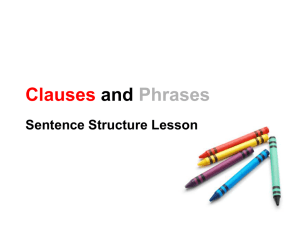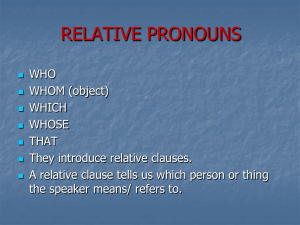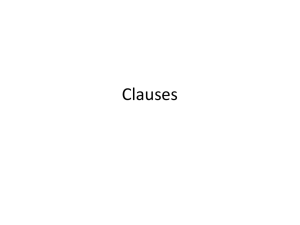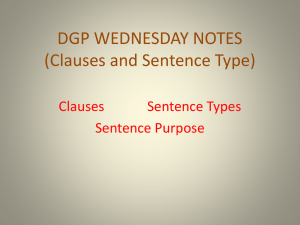Adjectives and clausal complementation ∗
advertisement
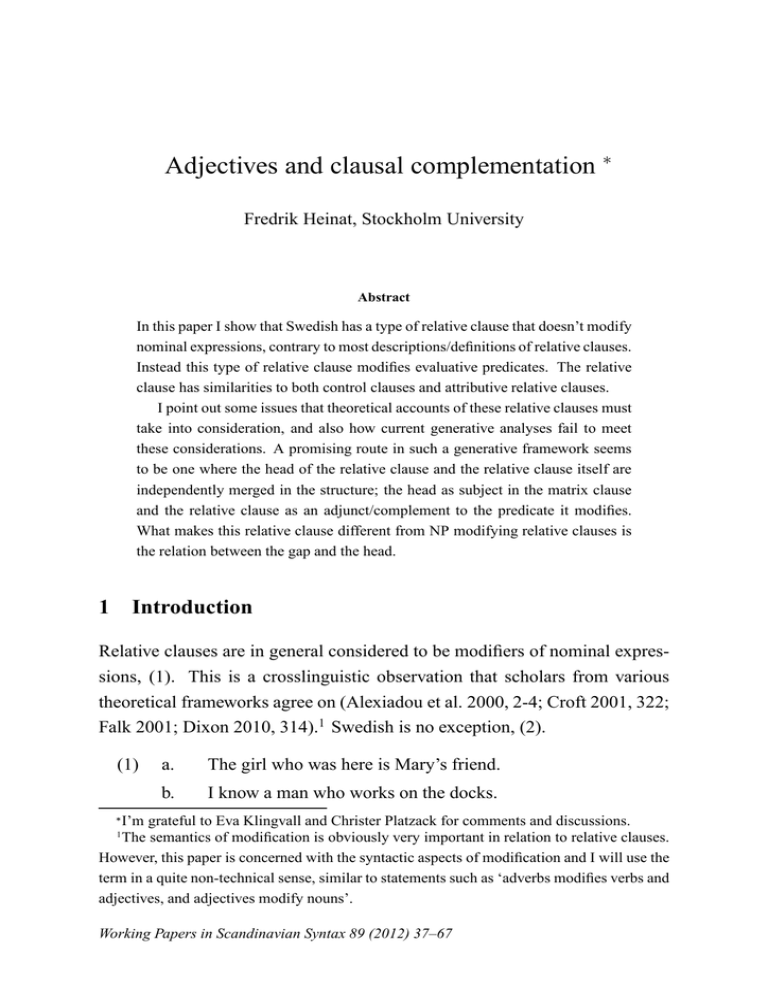
Adjectives and clausal complementation ∗ Fredrik Heinat, Stockholm University Abstract In this paper I show that Swedish has a type of relative clause that doesn’t modify nominal expressions, contrary to most descriptions/definitions of relative clauses. Instead this type of relative clause modifies evaluative predicates. The relative clause has similarities to both control clauses and attributive relative clauses. I point out some issues that theoretical accounts of these relative clauses must take into consideration, and also how current generative analyses fail to meet these considerations. A promising route in such a generative framework seems to be one where the head of the relative clause and the relative clause itself are independently merged in the structure; the head as subject in the matrix clause and the relative clause as an adjunct/complement to the predicate it modifies. What makes this relative clause different from NP modifying relative clauses is the relation between the gap and the head. 1 Introduction Relative clauses are in general considered to be modifiers of nominal expressions, (1). This is a crosslinguistic observation that scholars from various theoretical frameworks agree on (Alexiadou et al. 2000, 2-4; Croft 2001, 322; Falk 2001; Dixon 2010, 314).1 Swedish is no exception, (2). (1) a. The girl who was here is Mary’s friend. b. I know a man who works on the docks. I’m grateful to Eva Klingvall and Christer Platzack for comments and discussions. The semantics of modification is obviously very important in relation to relative clauses. However, this paper is concerned with the syntactic aspects of modification and I will use the term in a quite non-technical sense, similar to statements such as ‘adverbs modifies verbs and adjectives, and adjectives modify nouns’. ∗ 1 Working Papers in Scandinavian Syntax 89 (2012) 37–67 38 (2) a. Flickan som var h¨ar a¨ r Marias v¨an. the girl who was here is Mary’s friend ‘The girl who was here is Mary’s friend.’ b. Jag k¨anner en man som jobbar i hamnen. I know a man who works in the docks ‘I know a man who works on the docks.’ However, Swedish has one type of construction in which a predicate, an evaluative adjective, is modified by what appears to be a relative clause: (3) a. Flickan a¨ r dum som g˚ar dit. the girl is stupid that goes there ‘The girl is stupid to go there.’ b. Lars var sn¨all som hj¨apte mig. Lars was kind that helped me ‘Lars was kind to help me.’ The exact status of the clauses in italics in (3) is not clear, even if they are considered by Teleman et al. (1999, vol.4:486) to be extraposed attributive relative clauses. In contrast to other relative clauses, the subordinate clause in (3) shares syntactic and semantic properties with both control clauses and relative clauses. The purpose of this paper is on the one hand a close examination of these clauses, and on the other a discussion of what theoretical implications they have for linguistic theory. The outline of the paper is as follows. The second section is an examination of some general properties of these clauses and their semantics. It is shown that they indeed modify predicates, not NPs/DPs. The third section compares the clause to control clauses and I argue that classifying the clause as a control clause is very problematic. The fourth section compares the clause to relative clauses. I show that classifying it as a relative clause is problematic, too, but probably the best option. However, it is not the kind of relative clause that Teleman et al. (1999) claim it is.2 2 Teleman et al. (1999, vol.4:486) say “a special variant of the attributive clause is the extraposed relative subordinate clause with a function similar to an adverbial that indicates cause.”(my translation). 39 The classification as such is not the ultimate aim of the paper. The classification is rather a reflection of the approach that should be used in accounting for the missing argument, the so called gap, in the clause. If the italicized clauses are control clauses, we expect that the missing argument can be accounted for in parallel to other control clauses. This account is for obvious reasons theory dependent and may involve PRO, case positions and theta role assignment in the minimalist program, or functional/anaphoric control in LFG. If the clauses are relative clauses, we expect that the missing argument can be accounted for by means of the machinery a theory uses for accounting for gaps in relative clauses. The reason for restricting the options to control and relative clauses is that these are the only types of subordinate clauses in Swedish that can have implicit arguments.3 The fifth section discusses various linguistic theories in relation to this type of relative clause and what problems they have in accounting for predicate modifying relative clauses. The sixth section contains some concluding remarks. 2 The semantics In this section I will show that the italicized clauses (from now predicate modifying relative clauses, PMRCs) in (3) really modify predicates and not NPs. Also, I will show some general characteristics of the PMRC. First, the interpretation of the PMRC is that it restricts the predicate, not the subject NP in (3), repeated here: 3 a. Flickan a¨ r dum som g˚ar dit. the girl is stupid that goes there 3 I don’t make a distinction between control clauses and external case marking (ECM) clauses, and I don’t consider so called small clauses, as in (i). i Lisa gick hem full. Lisa walked home drunk ‘Lisa walked home drunk.’ 40 ‘The girl is stupid to go there.’ b. Lars var sn¨all som hj¨apte mig. Lars was kind that helped me ‘Lars was kind to help me.’ In (3a) it is possible to interpret the relative clause as an attributive extraposed relative clause (RC, from now) with the interpretation that the one who is stupid is the girl, and the RC helps to restrict the reference of the NP. However, this interpretation is not the salient one. In (3b) this NP restrictive interpretation is even harder to get since the NP is a proper name and proper names usually don’t require restriction. Proper names uniquely identify a referent by default. It is also possible to use a subject NP that doesn’t allow attributive RC modification at all. In (4) the first person pronoun resists RC modification, showing that the PMRC does not modify the antecedent to the gap, in other words it is not attributive. Another type of phrase that doesn’t allow RC modification is wh-words. In (4c) it’s impossible to interpret the RC as a modifier of the subject as shown in (4d) (4) a. b. Jag a¨ r dum som aldrig l¨ar mig. I am stupid that never learn refl ‘I am stupid never to learn.’ * Jag som aldrig l¨ar mig a¨ r dum. I that never learn refl is stupid ‘I who never learn is stupid.’ c. Vem a¨ r dum som aldrig l¨ar sig? who is stupid that never learn refl ‘Who is stupid never to learn.’ d. * Vem som aldrig l¨ar sig a¨ r dum? who that never learn refl is stupid ‘Who who never learns is stupid.’ In the predicate modifying interpretation the meaning of the sentences corresponds to the English translations with a non-finite clause. As shown by Stowell (1991), Kertz (2006) and Oshima (2009), among others the nonfinite clause is part/modifier of the adjective phrase. In Swedish the PMRC restricts 41 the predicate; in (3a) flickan ‘the girl’ is stupid only in relation to the event of ‘going there’; in (3b) Lars is kind only in relation to ‘helping me’. This restriction of the predicate gives the PMRC an interpretation which is similar to a causative or even conditional interpretation; the predication only holds under certain conditions. This is why Teleman et al. (1999, vol.4:486) claim the PMRC is similar to an adverbial that has causative interpretation. The fact that the PMRC modifies the predicate shows in what the sentences in (3) assert. In (3a) it isn’t contradictory to say: Flickan a¨ r dum som g˚ar dit, men hon a¨ r inte dum i the girl is stupid that goes there but she is not stupid in allm¨anhet. general ‘The girl is stupid to go there, but she isn’t stupid in general’ (5) If the RC is interpreted as modifying the NP, (5) is indeed a contradiction: Flickan som g˚ar dit a¨ r dum men hon a¨ r inte dum i the girl that goes there is stupid but she is not stupid in allm¨anhet. general ‘The girl who goes there is stupid, but she isn’t stupid in general’ (6) What RCs and PMRCs have in common is restrictive semantics. Attributive RCs restrict arguments and PMRCs restrict predicates. As we will see below, it is possible to extend the PMRC’s domain of restriction from adjectival predicates to nominal predicates. The PMRC is restricted to modifying evaluative predicates. Evaluative adjectives (EAs hereafter) have been recognized as a semantic category for a long time (Bolinger, 1961; Lees, 1960; Stowell, 1991; Kertz, 2006, 2010). Even though EAs seem to belong to a homogenous semantic class, not all adjectives in this class show the same syntactic behaviour. There are EAs that do not allow modification of PMRCs, for example intelligent ‘intelligent’ and beg˚avad ‘gifted’. Instead, they behave like non-EAs such as l˚ang ‘long’. (7) a. Johan a¨ r smart som g˚ar till tandl¨akaren regelbundet. John is clever that goes to the dentist regularly 42 ‘John is clever to go to the dentist regularly.’ b. * Johan a¨ r intelligent som g˚ar till tandl¨akaren regelbundet. John is intelligent that goes to the dentist regularly ‘John is intelligent to go to the dentist regularly.’ c. * Lisa a¨ r l˚ang som n˚ar upp till taket. Lisa is tall that reaches to the ceiling ‘Lisa is tall to reach the ceiling.’ In (7a), smart ‘clever’, is an EA that allows modification by a clause and intelligent in (7b) is an EA that doesn’t.4 As mentioned above, it’s possible to use PMRCs with predicative nouns. Some EAs have corresponding nouns, and when these nouns are used predicatively, they can be modified by a PMRC: (8) a. Han var en idiot som slog ihj¨al katten. he was an idiot that killed the cat ‘He was an idiot to kill the cat.’ b. Jag a¨ r en dumbom som inte betalar r¨akningarna. I am a fool that not pay the bills ‘I’m a fool not to pay my bills.’ We get the same interpretation here as in (3). It is only in relation to killing the cat that someone is an idiot, not in general. If these nouns are used referentially the interpretation is that of an RC and the wellformedness is marginal: (9) ?? Jag k¨anner en idiot som slog ihj¨al katten. I know an idiot that killed the cat ‘I know an idiot who killed the cat.’ In this section, I have shown that the PMRC really is a modifier of predicates rather than of nouns. What remains to show is that it indeed is a RC and not 4 One difference between EAs that allow modification and those that don’t seems to be the adjective’s ability to function as both a stage and an individual level predicate. Adjectives that readily get a stage level interpretation allow modification. I will not deal with the differences between different EAs in this paper. Nor will I try to work out a definition for them. I will simply use those that are ‘canonically’ evaluative. Teleman et al. (1999, vol.2:175) provide a list of evaluative adjectives. 43 a control clause. The major argument against a relative clause classification is the fact that PMRCs don’t modify nouns, in many descriptions a defining criterion for RCs. In the following sections the properties of the PMRC will be investigated in detail and compared to Swedish control clauses and relative clauses. As mentioned in the introduction the purpose is to determine the most probable approach to accounting for the relation between the subject in the main clause and and the gap in the PMRC. I will start by comparing PMRCs to control clauses. 3 Control The fact that the PMRC doesn’t modify the subject NP would in many descriptions (Platzack, 2000; Teleman et al., 1999; Dixon, 2010) disqualify it as an RC.5 The only viable option if this clause isn’t a type of RC is to treat as a type of control clause. In this section the PMRC will be compared to control clauses regarding both syntax and semantics. There are several similarities between the two types of clauses that could warrant a control classification of PMRCs. But, as I will show, there are a few facts that make such a classification very troublesome. First we will look at some indirect similarities that involve paraphrases. Second, we will look at the missing subject and then we will look at what I have called tense dependency. Finally we will look at some obvious differences between control clauses and PMRCs. 3.1 Indirect similarities There are two indirect reasons to classify the PMRC as a control clause: One is the fact that the paraphrases of (3), (10a) and (10b), contain nonfinite control clauses. 3 5 a. Flickan a¨ r dum som g˚ar dit. the girl is stupid that goes there ‘The girl is stupid to go there.’ I will get back to the criteria for RCs in section 4. 44 (10) b. Lars var sn¨all som hj¨apte mig. Lars was kind that helped me ‘Lars was kind to help me.’ a. Det var sn¨allt (av Lars) att hj¨alpa mig. it was kind (of Lars) to help me ‘It was kind (of Lars) to help me.’ b. Att g˚a dit var dumt (av flickan). to go there was stupid (of the girl) ‘To go there was stupid (of the girl).’ The other indirect reason is that PMRCs have the same interpretation as the nonfinite clauses that modify EAs in English: (11) a. John was stupid to kill the cat. b. Mary was kind to help me. The italicized clauses in (39) are analyzed as control clauses (see e.g. Kertz, 2010, and references therein). However, these two reason to treat the PMRC as a control clause are only indirect and bear on parallels to other constructions, rather than on the actual behaviour of the PMRC. 3.2 The subject gap If we turn to direct similarities between PMRCs and control clauses, there are two facts that speak in favour of a control clause analysis. The first is the fact that both PMRC and control clauses are the only types of clauses in Swedish where the gap is restricted to subjects (i.e. missing subjects). The second is the fact that there is some kind of tense dependency between the main clause and the embedded clause in both PMRC and control clauses. This dependency is not found between relative clauses and main clauses. We start by looking at the gapped position. As illustrated in (12), only subject gaps are allowed in control clauses in Swedish. (12) a. Maria ville tr¨affa Johan. Mary wanted meet John ‘Mary wanted to meet John.’ 45 b. Maria o¨ vertalade Johan att tr¨affa henne. Mary persuaded John to meet her ‘Mary persuaded John to meet her.’ c. * Maria har velat Johan tr¨affa – . Mary has wanted John meet – ‘Mary wanted that John should see her’. d. * Maria o¨ vertalade Johan att tr¨affa –. Mary persuaded John meet – ‘Mary wanted that John should see her’. Irrespective of whether we have subject control, as in (12a), or object control, (12b), only the subject in the non-finite clause can be gapped. It’s impossible to interpret a missing object as coreferential with a matrix subject, or object, as in (12c) and (12d). This is indeed the same pattern we find in the PMRC:6 (13) a. Flickan var sn¨all som hj¨alpte Lars. SUBJECT the girl was kind that helped Lars. ‘The girl was kind to help Lars.’ b. * Flickan var sn¨all som Lars hj¨alpte. OBJECT the girl was kind that Lars helped. ‘The girl was kind for Lars to help.’ c. * Flickan var sn¨all som Lars gav boken. IND . OBJ . the girl was kind that Lars gave the book ‘The girl was kind for Lars to give the book.’ d. * Flickan var sn¨all som Lars pratade med. OBJECT OF PREP. the girl was kind that Lars talked to ‘The girl was kind for Lars to talk to.’ There is one important difference between control clauses and PMRC regarding the subject gap. In PMRCs there is a semantic restriction on the missing subject. There is no such restriction in control clauses. According to Teleman et al. (1999, vol.4:505) the semantic role of the subject in the PMRC must be 6 Some of these examples are wellformed if the RC is interpreted as an extraposed attributive relative clause. I will return to this in section 4. 46 an agent. In sentence (14), the PMRC has a missing subject, but the sentence is still ill-formed, since the missing argument is not agentive. (14) * Demonstranten var dum som arresterades. the protester was stupid that was arrested However, the requirement is not strictly that the gapped subject be an agent (contra the claim in Teleman et al. 1999). It’s enough that the subject has some vague type of control or influence over the event described in the PMRC, or that it is an experiencer as in (15a). Passives formed with bli ‘become’, which imply that the subject has control over the described event, are well-formed. Compare (14) with (15b). Other paraphrases that allow for the subject to have some influence on the actions are also well-formed. For example, the verb l˚ata ‘let’ indicates that the subject has some kind of influence on an event, even though it is not an agent, and when this verb is used the sentence is wellformed (15d). It is possible, too, for the missing argument in the PMRC to have the semantic role of causer, which also involves control or influence, as in (15e) and (15f). (15) a. Pojken var tokig som var f¨or¨alskad i henne the boy was crazy that was in love with her ‘The boy was crazy to be in love with her.’ b. Demonstranten var dum som blev arresterad. the protester was stupid that became arrested ‘The protester was stupid to get arrested.’ c. Pojken var tokig som blev f¨or¨alskad i henne. the boy is crazy that gets in love with her ‘The boy is crazy to fall in love with her.’ d. Demonstranten var dum som l¨at sig arresteras. the protester was stupid that let refl arrested ‘The protester was stupid to let herself/himself be arrested.’ e. Demonstranten var dum som fick sin kompis the protester was stupid that had his/her friend arresterad. arrested ‘The protester was stupid to have his/her friend arrested.’ 47 f. Du var dum som hade honom att st¨amma mig. You were stupid that had him to sue me ‘You were stupid to have him sue me.’ The semantic requirement that the subject be in some kind of control of the action described in the clause indicating cause is probably induced by the EA. The same semantic restriction holds when the sentences are paraphrased with a causal finite clause with eftersom ‘since’: (16) a. * Demonstranten var dum eftersom hon arresterades. the protester was stupid since she was arrested ‘The protester was stupid since she was arrested.’ b. * Pojken var tokig eftersom han var a¨ lskad av henne the boy was crazy since he was loved by her ‘The boy was crazy since he was loved by her.’ The sentences in (16) show that the semantic restriction is not connected to the PMRC, but to the EA. 3.3 Tense dependency Another similarity between control clauses and PMRCs is tense dependency. Since control clauses in Swedish are non-finite, their tense interpretation is dependent on a tensed verb in a matrix clause.7 (17) a. Jag o¨ vertalade Lisa att diska. I persuaded Lisa to do the dishes ‘I persuaded Lisa to do the dishes.’ b. Jag ska o¨ vertala Lisa att diska. I will persuade Lisa to do the dishes ‘I will persuade Lisa to do the dishes.’ In (17) the interpretation of the nonfinite clause is that it takes place after the event in the main clause, irrespective of when that event took place, or will 7 I will not discuss participles, which are non-finite too. They have too different a distribution from infinitival clauses and PMRC to be relevant. 48 take place. Whether the event in the embedded clause takes place before or after the actual speech event is not determined when the matrix verb is in the past tense. In PMRC constructions there is tense dependency, too. (18) a. Pojken a¨ r dum som g˚ar dit. the boy is stupid that goes there ‘The boy is stupid to go there.’ b. Pojken var dum som gick dit. the boy was stupid that went there ‘The boy is stupid to go there.’ c. * Pojken var dum som g˚ar dit. the boy was stupid that goes there ‘The boy was stupid to go there.’ d. ? Pojken a¨ r dum som gick dit. the boy is stupid that went there ‘The boy is stupid to go there.’ e. ? Pojken a¨ r dum som ska g˚a dit. the boy is stupid that will go there ‘The boy is stupid to go there.’ f. Det var dumt av pojken att g˚a dit. It was stupid of the boy to go there ‘It was stupid of the boy to go there.’ g. Att g˚a dit var dumt av pojken. to go there was stupid of the boy ‘To go there was stupid of the boy.’ The tense dependency holds between the PMRC and its matrix clause. Unless the tenses in the matrix clause and the PMRC are the same, the sentences are ill-formed, (18c), but given that the event in the PMRC is quite recent it is possible to have present tense in the matrix clause, (18d). Also if the event in the PMRC is intended to take place, different tenses are possible, (18g). There is a logical requirement that the event, or the intention of carrying out the event, in the PMRC overlaps with the state of the adjective. Therefore the state that the adjectives refers to cannot have ended when the event in the 49 PMRC (intends to) takes place, as in (18c). Since the paraphrases in (18f) and (18g) have nonfinite control clauses there is tense dependency in these too. There are two options regarding the tense dependency in the PMRC. Either the tense in the PMRC is ‘independent’ or it is ‘parastic’ on the tense in the matrix clause. ‘Parasitic’ means that the tense morphology is but a marker without any independent tense semantics. Multiple marking of verbal morphology is also called ‘multiple exponence’ by Sells (2004). This kind of parasitic verb morphology is well described in Swedish (Anward, 1988; Hedlund, 1992; Wiklund, 2001, 2007; Sells, 2004). The question is if the tense marking in the PMRC is parasitic on the tense in the matrix clause. If the tense marking on the verb in the PMRC is parasitic, it would be a very strong argument for treating the PMRC as a control clause, since the verb on some level of representation would lack tense, just as the non-finite verb in control clauses. So let us look at the multiple exponence of verb-verb agreement that we find in Swedish. In (19) the two sentences are identical syntactically and semantically and the parasitic supine in (19b) is only a ‘surface’ form. (19) a. Flickan skulle ha kunnat g¨ora det. the girl would have be.able(sup) do(inf.) it ‘The girl would have been able to do it to do it.’ b. Flickan skulle ha kunnat gjort det. the girl would have be.able(sup) done(sup.) it ‘The girl would have been able to do it.’ The supine is not the only form that can be parasitic in Swedish. We find the same parasitic pattern in imperatives, (20), fronted VPs, (21), and possibly even passives (22).8 (20) 8 a. Sluta skrika! stop(imp.) shout(inf.) ‘Stop shouting!’ It’s unclear whether the passive form ‘beh¨ovs’ need in (22b) is parasitic or a real passive form. More research is needed on this topic. 50 (21) b. Sluta skrik! stop(imp.) shout(imp.) ‘Stop shouting!’ a. offentligt g¨or hon inte. Dansar dances(pres.) in public does(pres.) she not ‘She will not DANCE in public.’ b. c. d. (22) * Dansa offentligt g¨or hon inte. dance(inf.) in public does she on the other hand not ‘She will not DANCE in public.’ Dansade offentligt gjorde hon inte. danced(past) in public did(past) she not ‘She would not DANCE in public.’ * Dansa offentligt gjorde hon inte. dance(inf.) in public did(past) she not ‘She would not DANCE in public.’ a. Det beh¨over k¨opas dricka till festen. it needs bought(pass) drinks for the party ‘Drinks need to be bought for the party.’ b. Det beh¨ovs k¨opas dricka till festen. it need(pass) bought(pass) drinks for the party ‘Drinks need to be bought for the party.’ There is no semantic difference between the pairs in (19) to (22). Where there is alternations between the base form and a parasitic form, the parasitic form is characteristic of spoken and informal registers. The fact that there’s parasitic tense marking in Swedish in other clause types may be an indication that the tense dependency we find between the PMRC and its matrix clause is of the same kind. However, there are restrictions on parasitic tense marking. As Wiklund (2001) points out, the domain for parasitic tense is the clause and tense only spreads between lexical verbs and auxiliaries, never between two lexical verbs.9 PMRCs violate both these constraints. The tense dependency 9 The exception is so called pseudocoordination where two lexical verbs are coordinated. The first verb is usually a verb of posture and the coordination has aspectual meaning: 51 is between two lexical verbs, and the verbs are in two different clauses. If the matrix clause is embedded in a context which makes it nonfinite the PMRC must still be finite. An indication that the tense marking in the PMRC is not parasitic on tense in the matrix clause: (23) a. Hon ans˚ag honom vara dum som gick dit she considered him stupid that went there b. Hon anser honom vara dum som g˚ar dit she considers him stupid that goes there c. * Hon ans˚ag honom vara dum som g˚a dit she considered him stupid that go there d. * Hon anser honom vara dum som g˚a dit she considers him stupid that go there Also, in all other cases of parasitic verb morphology, the parasitic form is not obligatory. There is variation between the infinitival form and the inflected parasitic form.10 From sentences (23c) and (23c) it is clear that there is no such variation of the verb forms in PMRCs. The conclusion is that the tense dependency we find between the tense in the matrix clause and the PMRC is not of the parasitic kind and both clauses contain independent tense marking. The fact that PMRCs have tense makes them very different from control clauses which must be nonfinite in Swedish. To conclude the sections on similarities between PMRC and control clauses. It seems that the two strongest arguments for classifying PMRCs as control clauses are: 1. the requirement that the missing argument be a subject, and 2. the requirement that the main clause and the PMRC have the same tense, i.e. tense dependency. In the next section we shall look at the differences we find between these two clause types. i Lisa satt och l¨aste /sitter och l¨aser. Lisa sat and read /sits and reads ‘Lisa is reading/was reading.’ In psedocoordination the tense on the verbs must be the same. Since the conjunction och ‘and’ is obligatory I will not make any comparisons to this construction. 10 Fronted VPs are an exception where tense on both verbs is obligatory for most speakers of Swedish. 52 3.4 Differences There are several differences between PMRCs and control clauses. In addition to the difference regarding the semantic role of the subject gap and tense, described in the previous sections, there are distributional differences between the clause types. Control clauses can be fronted, (24a), whereas PMRCs cannot, (24b). (24) a. b. Att g˚a p˚a bio o¨ vertalade jag honom. to go to movie persuaded I him ‘To go to the movies, I persuaded him to do.’ * Som g˚ar dit, a¨ r han dum. that goes there, is he stupid ‘To go there, he is stupid.’ PMRCs only follow evaluative predicates, as mentioned in section 2. Control clauses, in contrast, follow any predicate that subcategorizes for infinitival clauses. The important thing is that control clauses and PMRCs are in complementary distribution. We never find infinitival clauses after evaluative adjectives, (25a) and (25b) and we never find PMRC after predicates that select for control clauses (25c) and (25d). This is an unexpected distribution if PMRC were a kind of control clause. (25) a. * Lisa a¨ r dum att g˚a dit. Lisa is stupid to go there b. * Pojken a¨ r sn¨all att hj¨alpa till. the boy is kind to help out c. * Lisa o¨ nskade som diskar. Lisa wished that does the dishes d. * Lisa o¨ vertalade Johan som diskar. Lisa persuaded John that does the dishes To sum up the differences between control clauses and PMRCs, there are all in all four clear differences between the two. Control clauses are nonfinite, have no semantic restriction on their subject gap, can be fronted and are not restricted by the semantics of their selecting predicate. PMRCs are finite, 53 have a semantic restriction on their subject gap and cannot be fronted and are restricted by the semantics of their selecting predicates; they must modify evaluative predicates. 3.5 Control or not? How the properties of control clauses are accounted for depends on the theoretical framework one chooses to adopt. If PMRC are categorized as control clauses the following facts are accounted for, presuming that the chosen theoretical framework has an account of the properties of control. • The missing argument must be a subject, since that’s the only argument that can be missing in control clauses in Swedish. What remains unaccounted for if the clause is categorized as a control clause, are the following facts: • the requirement that the gapped subject have a semantic role that involves control, or is anything but theme. • the impossibility of fronting and the complementary distribution of other control clauses. • the requirement that the PMRC be tensed, past or present, but not nonfinite. Since all control clauses in Swedish are nonfinite, infinitival or participial, categorizing the finite PMRC as a control clause will have consequences for any account of control. This tense difference is on its own enough to disqualify PMRCs as an instance of control, I would say. The problem that follows if PMRCs are classified as control clauses is that the lack of tense/finiteness is often a necessary condition in theoretical analyses of control clauses (Chomsky, 1981; Bresnan, 1982; Falk, 2001). Having dismissed a categorization of the PMRC as a type of control clause, we now turn to its similarities and differences compared to relative clauses. 54 4 Relative clauses Even though the PMRC looks like an RC, it differs in one important way: it isn’t a modifier of the gapped noun phrase. Dixon (2010, 314) lists four characteristics of relative clause constructions. The main points of these characteristics are given in (26): (26) a. The construction involves two clauses making up one sentence which consists of a single unit of intonation. b. The underlying structures of these two clauses must share an argument (called the common argument (CA)). The CA is understood to function as an argument in the main clause (MC) and as an argument in the RC . c. The RC functions as a syntactic modifier11 of the the CA in the MC. At the semantic level it will normally provide information about the CA which assists in focussing–or restricting–the reference of the CA (restrictive RC), or provide further information about the CA (non-restrictive RC). d. The RC must have the basic structure of the clause, involving a predicate and the core arguments required by that predicate. Compared to control clauses there is actually only one of Dixon’s criteria that distinguishes RCs from control clauses, and that is (26c). This is exactly the criterion that PMRCs fail to meet. That RCs modify nouns is taken for granted in both descriptive (Nikolaeva, 2006) and theoretical work (Platzack, 2000; Dalrymple, 2001; Falk, 2001) or as Alexiadou et al. (2000, 2) put it: “The best studied case of [noncanonical complementation] is the relative clause construction, in which the clause is embedded inside a nominal expression which it modifies.”(my emphasis). Since PMRCs don’t modify nominal expressions they clearly fail to meet the modification criterion. However, in this section I will show that even 11 It’s not clear what Dixon means by ‘syntactic modifier’ since most of his criteria for RCs are semantically based. 55 though they fail to do that, their similarities to RCs are too many to be a coincidence. First, I will compare PMRCs to restrictive and non-restrictive RCs. After that we will look at some syntactic similarities and dissimilarities, and finally there will be a comparison of some semantic parameters. Semantically there is a difference between restrictive and non-restrictive RCs, and some would say that there are syntactic differences as well (Kayne, 1994; Platzack, 2000). Restrictive RCs are necessary modification in the sense that they delimit the set of possible referents of elements referred to by the common argument, and non-restrictive RCs gives extra information about an independently established referent (Dixon, 2010; Teleman et al., 1999, vol.4:486). In Swedish, non-restrictive relatives are possible to modify with the phrase f¨or o¨ vrigt ‘by the way’ (see Platzack, 2000), as in (27a). From (27b) it is clear that PMRCs are not non-restrictive relative clauses, since they are impossible to modify with f¨or o¨ vrigt. (27) a. b. En man var h¨ar ig˚ar som, f¨or o¨ vrigt, k¨ande Lisa. A man was here y-day, that, by the way knew Lisa. * Pojken a¨ r dum som, f¨or o¨ vrigt, g˚ar dit. the boy is stupid that, by the way goes there. Swedish and other Scandinavian languages are famous for their possibilities to extract out of relative clauses, (Andersson, 1974; Allwood, 1976; Engdahl, 1980, 1982, 1997; Taraldsen, 1982, a.o). One of the restrictions on extractions is that the relative clause is restrictive (compare (28) and (30)) (Teleman et al., 1999, vol 4:500). Taraldsen (1982) claims that extraposition of the relative clause is obligatory for extraction to take place, and sometimes it is even string vacuous. In (28) the RC has moved to a position to the left of the adverbial ig˚ar ‘yesterday’ and in (29) the RC is, according to Taraldsen (1982), in the same extraposed position.12 Given the right context, extraposition out of the PMRC is possible, (31) and (32); a further indication that 12 Taraldsen (1982) uses sentences that involve phrasal verbs and stacked relatives, not the kind of sentences in (28)-(32). 56 PMRCs are not non-restricted relative clauses.13 (28) S˚ana blommor stod en man p˚a torget i g˚ar som s˚alde those flowers stood a man at the square y-day that sold ‘A man who sold flowers like that was in the square y-day. (29) S˚ana blommor k¨anner jag en man som s¨aljer. those flowers know I a man who sells ‘Flowers like that, I know a man who sells them’ (30) * S˚ana blommor stod en man p˚a torget i g˚ar som f¨or o¨ vrigt those flowers stood a man at the square y-day that by the way s˚alde sold ‘A man who sold flowers like that was at the square y-day, by the way.’ (31) Har du h¨ort att Nilsson knappt s¨aljer n˚agon mj¨olk nuf¨ortiden? ‘Have you heard that Nilson sells hardly any milk nowadays?’ ? Ja, och den sista kon som gav mj¨olk var han v¨aldigt dum Yes, and the last cow that gave milk was he very stupid som s˚alde. that sold ‘Yes, and he was very stupid to sell the last cow that gave any milk.’ (32) Jag vet inte hur jag ska orka springa. Jag har inte tr¨anat p˚a veckor. ‘I don’t know how I will be able to run. I haven’t exercised in weeks’. ? Stockholm maraton var du ju vansinnig som anm¨alde dig Stockholm marathon were you part. insane that registered refl till d˚a. for then ‘Then you were insane to register for STHLM marathon.’ The conclusion is that if PMRCs are RCs, they are of the restricted kind. The PMRCs show other characteristics in common with RCs. First, both are 13 Extractions out of relative clauses are very sensitive to context and lexical semantics which makes it difficult to come up with fully wellformed examples, see Engdahl (1997, a.o.) 57 introduced by the subjunction som. Second, both types of clauses are finite. Third, as mentioned in section 3, PMRCs cannot be fronted, (33a), and neither can RCs, (33b). (33) a. * Som g˚ar dit, a¨ r han dum. ‘To go there, he is stupid’. b. * Som jag k¨anner, kommer en flicka idag. ‘That I know, a girl comes today’ However, there are differences between the two types of clauses as well. In contrast to control clauses, there are no restriction on what arguments can be left out in Swedish RCs. In Swedish an NP with any syntactic function in the matrix clause can be relativized, and the missing argument in the RC can have any syntactic function (Teleman et al., 1999, vol.4:485): (34) a. Flickan som sjunger. SUBJECT the girl who sings b. En bok som Lisa l¨aste. OBJECT a book that Lisa read c. L¨araren som Lisa gav en bok. INDIRECT OBJECT the teacher that Lisa gave a book d. Hyllan som boken st˚ar i. PREP. OBJ . the shelf that the book stands in ‘The shelf that the book is on.’ This is not possible with PMRCs. As shown before, there is a strict requirement that the missing argument be the subject. Since any argument can be relativized in RCs, there is no semantic requirement that the missing argument be in control of the event described in the RC. In section 3, example (16), it was shown that this requirement was induced by the evaluative predicate, not the PMRC itself, and it holds in other subordinate clauses too. A further difference between PMRCs and RCs concerns extraposition. Swedish relative clauses can optionally be extraposed, as in (35).14 The 14 According to Teleman et al. (1999, vol.3: ch 21), the conditions under which extraposed relative clauses are possible are not very well researched and I will not pursue this topic here. 58 PMRC is different. It can only get a predicate modifying interpretation when it is adjacent to the adjective. In (35) the meaning of the two sentences are the same, and the position of the attributive relative clause does not make a difference. When there is an EA, the position of the RC is important. If the clause is adjacent to the antecedent of the gap, the interpretation is that of a (non-) restrictive RC, (35c). It is only in the extraposed position that it is possible to get the predicate modifying interpretation discussed in section 2. (35) a. Nu a¨ r mannen som s¨aljer dammsugare h¨ar igen. now is the man that sells vacuum cleaners here again ‘Now is the man who sells vacuum cleaners here again.’ b. Nu a¨ r mannen h¨ar igen som s¨aljer dammsugare. now is the man here again that sells vacuum cleaners ‘Now is the man here again who sells vacuum cleaners.’ c. Mannen som s¨aljer dammsugare a¨ r tokig. the man that sells vacuum cleaners is stupid ‘The man who sells vacuum cleaners is stupid.’ This difference in position is crucial for for the different interpretations that RCs and PMRCs get. In fact, it is somewhat confusing to call the PMRC extraposed as Teleman et al. (1999) do, since it is not extraposed from the element it modifies. It modifies the evaluative predicate, which it is adjacent to. However, it is possible to extrapose the PMRC, with maintained predicate modifying interpretation:15 (36) Lisa var dum ig˚ar som gick dit. Lisa was stupid y-day that went there ‘Lisa was stupid yesterday to go there.’ Another similarity between PMRCs and RCs is the distribution. Wherever an RC can occur we can have a PMRC. The only difference seems to be what they restrict, RCs restrict referential expressions and PMRCs restrict evaluative predicates. 15 I’m grateful to Christer Platzack for providing this example. 59 4.1 Relative clause or not? Categorizing the clause following an EA as an RC, accounts for the following facts: • The missing argument in a tensed clause • the use of the relative subjunction som • The restricting interpretation of the clause. • The requirement of extraposition and that a non-extraposed clause gives a different interpretation and may even induce illformedness. What remains unaccounted for if the clause is a RC, are the following facts: • The requirement of missing subject and the fact that it must have some control over the event in the PMRC. Even though PMRCs differ in these respects from RCs, I think the data on the whole this favours an RC-analysis of PMRCs. But instead of modifying referential expressions, such as NPs, they modify predicates, or at least predicative evaluative adjectives and nouns. The next section examines the phrase structure of the adjective phrase and the PMRC. 5 Phrase structure The PMRC cannot be fronted: (37) a. * Som g˚ar dit, a¨ r han dum. ‘To go there, he is stupid’. b. * Som inte betalade r¨akningarna a¨ r jag dum. ‘Not to pay the bills, I am stupid.’ This indicates that the PMRC is internal to the adjective phrase. The fact that fronting of the EA together with the PMRC supports such a structure: 60 (38) Fronting a. Dum som slog hunden var han. stupid that hit the dog was he b. En idiot som slog hunden var han. an idiot that hit the dog was he c. Dum var han som slog hunden. Stupid was he that hit the dog d. En idiot var han som slog hunden. An idiot was he that hit the dog The fact that the adjective can be fronted on its own is probably a case of predicate fronting, as in (39) (39) (40) Springer g¨or han. runs does he ‘Running is what he’s doing.’ a. * Hur dum som sl˚ar hunden a¨ r Johan? how stupid that hits the dog is John b. ? Hur dum a¨ r Johan som sl˚ar hunden? how stupid is John that hits the dog Wh-movement seems to favour a structure where the PMRC isn’t part of the AP, but the status of the sentences is questionable. (41) Exclamations a. ? Vad dum som inte betalade r¨akningarna jag var! What stupid that not paid the bills I was b. Vad dum jag var som inte betalade r¨akningarna! What stupid I was that not paid the bills ‘How stupid I was not to pay the bills’. c. ? Vilken idiot som inte betalade r¨akningarna jag var! What an idiot that not paid the bills I was d. Vilken idiot jag var som inte betalade r¨akningarna! What an idiot I was that not paid the bills 61 Again, the PMRC-clause doesn’t seem to form a constituent with the EA or EN. However, end-weight may play a role here as well as in the case with wh-movement. (42) Pro-forms a. Johan var dum som slog hunden och det var Lisa med. John was stupid that hit the dog and that was Lisa too. ‘John was stupid to hit the dog and so was Lisa’. b. * Johan var dum som slog hunden och det var Lisa med John was stupid that hit the dog and that was Lisa too som slog katten. that hit the cat c. Johan var en idiot som slog hunden och det var Lisa med. John was an idiot that hit the dog and so was L too d. *? Johan var en idiot som slog hunden och det var Lisa med John was an idiot that hit the dog and that was Lisa too som slog katten. that hit the cat Proforms indicate that the PMRC is part of AP. It is not clear whether it is a part of the predicative noun, though.16 One possible structure of the construction is: (43) VP AP V var A RC dum som slog hunden Also, the fact that the PMRC cannot occur without the adjective indicates that it is part of the AP. Whether it is an adjunct or an argument is difficult to say. The fact that only EAs can have PMRCs indicates that it is an argument, but the adverbial modification indicates adjunct status. 16 Even though it is important, I will not be concerned with the structure of the predicative DP in this paper. 62 6 Theoretical considerations This section briefly points out some of the problems that a theoretical analysis of PMRCs must account for. The perspective is from a generative framework (Kayne, 1994; Chomsky, 2001). There are two key issues that are in need of explanation. The first is how the gap in the PMRC can be related to the subject of the PMRC’s matrix clause, without inducing a noun modifying semantics. The second is how to account for the predicate modifying interpretation. Since the PMRC doesn’t modify the common argument, or head, any head internal analysis (Kayne, 1994; Platzack, 2000) of it will give the wrong semantics. An analysis along these lines will also The subject gap in the PMRC: have to involve substantive movement of the head, from an PMRC internal position to the subject position of the matrix clause. As has been pointed out previously (Borsley, 1997, among others), the noun and the determiner does not form a constituent in head internal analyses of RCs. In his analysis of Swedish RCs, Platzack (2000) assumes the following structure: (44) DP D NP N CP flickan DP Opi C’ som ti gick dit If (44) was the structure in the PMRC, the subject flickan is made up of D0 and N0 , which isn’t a constituent. In an analysis involving remnant movement this is avoided by first moving the CP and then moving the DP. Apart from the apparent ad hoc solution that this kind of movement operation involves, it still gets the semantics wrong. Such an approach to accounting for the subject gap predicts that the PMRC modifies the subject DP and not the evaluative 63 predicate. Platzack (2000, 285-288) provides a different analysis for extraposed relative clauses. He recognizes the problem with moving the subject/head when it isn’t a constituent. For extraposed RCs he proposes that the head is externally merged in the subject position and the gap in the extraposed RC is filled by an operator:17 (45) [DP [D0 somi] [N P [N 0 ti ] [CP Opj [C 0 ti ] [vP tj g˚ar dit]]]] Applied to PMRCs, this kind of analysis, without modification, would predict that the PMRC modifies the subject rather than the evaluative adjective. Just as Kayne’s raising analysis in (44). The predicate modifying interpretation: A related issue is how the PMRC can modify a predicate. It seems that the PMRC is embedded under the predicate it modifies, and not just extraposed to the end of the matrix clause. The consequence of this is that it is not possible to apply the same analysis to PMRCs and RCs, extraposed or not. The most obvious way to account for the predicate modifying interpretation is to assume that the PMRC is selected by the evaluative predicate, or perhaps optionally introduced just like an adverbial. As pointed out above, this relation to the predicate makes it very difficult to account for the subject gap. Neither the operator analysis nor the raising analysis gives the right semantics. The most fruitful way to go about this problem is presumably to tease out the semantic properties of the operator in the operator analysis. The PMRC is merged with the predicate it modifies, just like most other modifiers, except for example extraposed relative clauses. The PMRC and RCs are not very different syntactically, the difference lies in the type of operator that they have. Exactly what this difference is, is a topic of ongoing research. 17 The structure in (45) is a simplified version of Platzack’s (37). 64 7 Conclusion In this paper I have shown that despite the fact that PMRCs don’t modify nominal expressions, contrary to most descriptions/definitions of relative clauses, they are a type of relative clause. They modify evaluative predicates. They have similarities to control clauses, but also differences. The fact that control clauses are non-finite in Swedish and PMRCs finite, makes any attempt to give them a unified account very complicated and it has far reaching consequences for current theoretical analyses of control. It was shown that tense in the PMRC is an independent tense that isn’t parasitic on its matrix clause. Had it been, a control analysis would probably be the best option. Instead the PMRC show many similarities to relative clauses and it seems that it is a subclass of relative clauses. It has more restrictions on it than RCs, but none of these restrictions violates any RC restriction. The crucial difference to RCs, though, being that PMRCs restrict predicates, not nouns. I have pointed out some issues that a theoretical account of PMRCs must take into consideration, and also how current generative RC analyses fail to meet these considerations. The most promising route in such a framework seems to be one where the head of the PMRC (the common argument in Dixon’s terms (2010)) and the PMRC itself are independently merged in the structure; the head as subject in the matrix clause and the PMRC as an adjunct/complement to the predicate it modifies. What makes PMRCs different from RCs is the relation between the gap and the head. The exact nature of this relation is the topic of ongoing research and hopefully the results will shed light on both predicate modification and the relation between gaps and their long distance dependencies to arguments. References Alexiadou, Artemis, Paul Law, Andr´e Meinunger, and Chris Wilder. 2000. Introduction. In The syntax of relative clauses, ed. Artemis Alexiadou, Paul 65 Law, Andr´e Meinunger, and Chris Wilder, Linguistics Today 32, 1–51. Amsterdam: John Benjamins. Allwood, Jens. 1976. The complex NP constraint as a non-universal rule and some semantic factors influencing the acceptability of Swedish sentences which violate the CNPC. In University of Massachusetts Occasional Papers in Linguistics ii, ed. J. Stillings, 1–20. Amherst, Ma. Andersson, Lars-Gunnar. 1974. Topicalization and relative clause formation. Gothenburg Papers in Theoretical Linguistics 25. Anward, Jan. 1988. Verb-verb agreement in swedish. In Mcgill Working Papers in Linguistics: Special issue on Comparative Germanic Syntax, ed. D. Fekete and Z. Laubitz, 1–35. Montr´eal: Depatment of Linguistics, McGill University. Cited in sells04. Bolinger, Dwight L. 1961. Syntactic blends and other matters. Language 37:366–381. Borsley, Robert. 1997. Relative clauses and the theory of phrase stucture. Linguistic Inquiry 28:629–647. Bresnan, Joan. 1982. Control and Complementation. In The mental representation of grammatical relations, ed. Joan Bresnan, 282–390. Cambridge, MA.: MIT Press. Chomsky, Noam. 1981. Lectures on Government and Binding. Studies in Generative Grammar 9. Dordrecht: Foris. Chomsky, Noam. 2001. Derivation by Phase. In Ken Hale: a life in language, ed. Michael Kenstowicz, 1–52. Cambridge, Mass.: MIT Press. Croft, William. 2001. Radical Construction Grammar. New York: Oxford University Press. Dalrymple, Mary. 2001. Lexical Functional Grammar. San Diego, CA.: Academic Press. 66 Dixon, Robert M. W. 2010. Basic linguistic theory, volume 2. New York: Oxford. Engdahl, Elisabet. 1980. Wh-constructions in Swedish and the relevance of subjacency. Proceedings of NELS 10:98–108. Cahiers Linguistiques d’Ottawa. Engdahl, Elisabet. 1982. Restrictions on unbounded dependencies in Swedish. In Readings on unbounded dependencies in Scandinavian languages, ed. Elisabet Engdahl and Eva Ejerhed, 151–174. Stockholm: Almquist & Wiksell International. Engdahl, Elisabet. 1997. Relative clause extractions in context. Working Papers in Scandinavian Syntax 60:51–79. Falk, Yehuda N. 2001. Lexical-functional grammar: An introduction to parallel constraint-based syntax. Stanford, CA.: CSLI Publications. Hedlund, Cecilia. 1992. On Participles. Stockholm: Stockholm University, Department of Linguistics. Kayne, Richard S. 1994. The antisymmetry of syntax. Linguistic Inquiry Monograph 25. Cambridge, Mass.: MIT Press. Kertz, Laura. 2006. Evaluative adjectives: An adjunct control analysis. In Proceedings of the 25th west coast conference of formal linguistics, ed. Donald Baumer, David Montero, and Michael Scanlon, 229–235. Sommerville, MA: Cascadilla Press. Kertz, Laura. 2010. The argument structure of evaluative adjectives. In Movement theory of control, ed. Norbert Hornstein and Maria Polinsky, 269–297. Amsterdam: John Benjamins. Lees, R. B. 1960. A multiply ambiguous adjectival construction in English. Language 36:207–221. Nikolaeva, Irina. 2006. Relative Clauses. In Encyclopedia of language and linguistics, ed. Keith Brown, 501–508. Amsterdam: Elsevier, 2 edition. 67 Oshima, David Y. 2009. Between being wise and acting wise: A hidden conditional in some constructions with propensity adjectives. Journal of Linguistics 45:363–393. Doi:10.1017/S0022226709005684. Platzack, Christer. 2000. A complement-of-N0 account of restrictive and nonrestrictive relatives. In The syntax of relative clauses, ed. Artemis Alexiadou, Paul Law, Andr´e Meinunger, and Chris Wilder, Linguistics Today 32, 265–308. Amsterdam: John Benjamins. Sells, Peter. 2004. Syntactic information and its morphological expression. In Projecting morphology, ed. Louisa Sadler and Andrew Spencer, 187–225. Stanford, CA: CSLI Publications. Stowell, Tim. 1991. The alignment of arguments in adjective phrases. In Perspectives on phrase structure, ed. Susan D. Rothstein, 105–135. San Diego: Academic Press. Taraldsen, Knut Tarald. 1982. Extraction from relative clauses in Norwegian. In Readings on unbounded dependencies in Scandinavian languages, ed. Elisabet Engdahl and Eva Ejerhed, 205–221. Stockholm: Almquist & Wiksell International. Teleman, Ulf, Staffan Hellberg, and Erik Andersson. 1999. Svenska akademiens grammatik. Stockholm: Norstedts Ordbok. Wiklund, Anna-Lena. 2001. Dressing up for lexical insertion: the parasitic supine. Natural Language and Linguistic Theory 19:199–228. Wiklund, Anna-Lena. 2007. The syntax of tenselessness: Tense/mood/aspectagreeing infinitivals. Berlin: Mouton de Gruyter.


